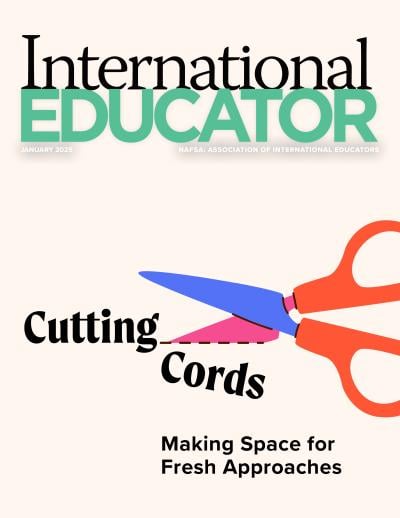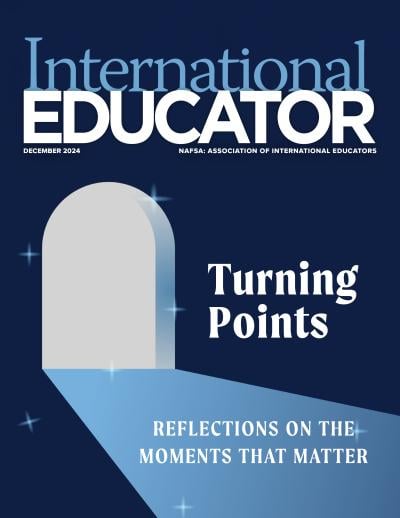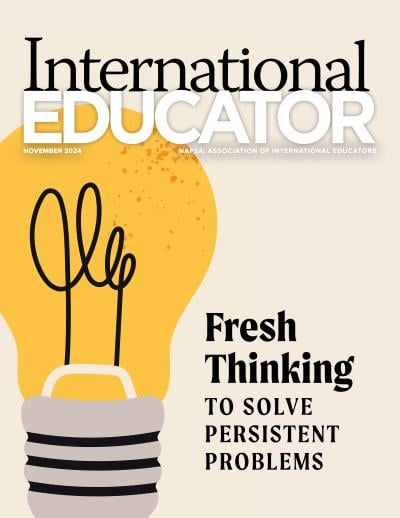On the Rise: State Consortia

International education consortia have a dual purpose for U.S. institutions. They band institutions together in pursuit of a common mission, as well as allow each participating institution to uniquely deliver affordable, high-quality student experiences; promote distinct brands; refine value propositions; and monitor return on investment (ROI). There are 30 state-level consortia (Pennsylvania has two) registered with the U.S. Commercial Service, and most have adopted a “StudyState” naming convention.
While state consortia have been playing a larger role in member institutions’ international student recruitment and enrollment plans for several years, an additional, highly relevant mission has recently developed. Consortia are emerging as potent political and economic lobbying bodies. This new, significant role has prompted a re-examination of the utility of and need for consortia among the states currently without one, as well as institutions that have chosen not to participate in their state’s consortium.
The Origins of State Consortia
In 1966, New Hampshire established the first state consortium (the city of Pittsburgh, Pennsylvania, hasan older one, but originally, it was not statewide). Consortia were formed initially to increase international visibility for their state and region, thereby attracting international students.
“There are people in the United States, and certainly abroad, who do not know where Tennessee is,” says Takeo Suzuki, executive director of The Center for Global Education at the University of Tennessee- Chattanooga (UT-Chattanooga), an institutional member of Study Tennessee. “It’s best first to increase awareness of Tennessee as one brand. Without a demand for Tennessee itself, individual Tennessee-based institutions struggle for market share.”
Consortia started as nonprofit entities launched by volunteers from colleges and universities across a state to explore ways to use limited resources to market their shared geographic locations, along with the member institutions’ programs. These consortia were governed by all-volunteer boards of directors from equal member institutions. Since their inception, consortia have been quite labor-intensive and subsisted through dedicated volunteerism.
“A successful consortium depends on true believers in the mission of higher education, and that depends on people willing to commit time outside of the limited scope of their jobs,” says Todd Shumway, director of global exchange at the University of Hawaii-Hilo, which is part of the Study Hawai'i state consortium.
Increased Recruitment Opportunities
State consortia facilitate cost-sharing marketing activities, including internationally targeted public-private collaborations, profiles on virtual recruitment platforms, and a formal presence at conferences, such as Study Tennessee’s joint booth with the U.S. Commercial Service at the NAFSA 2018 Annual Conference & Expo. Additionally, consortia often have the weight and gravitas to both dispatch international delegations and welcome visiting delegations, such as the Kazakhstan delegation that toured Study Colorado member institutions as guests of the consortium.
Recruitment trips with representatives of member institutions are one of the chief benefits for institutions that belong to their state consortium. Joseph E. Harden, student services coordinator at the Maryland English Institute, says the recruitment trip to China and South Korea organized by Study Maryland yielded connections with potential partners seeking a summer intensive English program. Similarly, Study Hawai'i has hosted five delegations to Asia in the last few years. Participants visited China, Hong Kong, Japan, Korea, and Taiwan to meet with alumni, high school students, educational agents, educational administrators, and government representatives, and they attended recruitment fairs and host presentations.
Before a recruiting trip to Mexico with the Texas state consortium, Heather Catton, director of the Office of International Programs at Stephen F. Austin State University in Nacogdoches, Texas, worried that her smaller institution would be overshadowed by larger or elite private institutions. Instead, she found genuine collegial comraderie, and because the group was representing the entire state of Texas, participants listened to prospective students’ needs and matched them with member institutions for the best fit.
Consortia provide the opportunity for member institutions to build strategic relationships among one another. “The biggest benefit of state consortium is getting to know your sister institutions across the state and being able to share information without feeling like you may be stepping on someone else’s toes,” says Catton.
International education consortia can create accessible platforms for international students seeking degree and intensive English programs. Some consortia have developed websites that host resources about financing education in the United States, student visas, intensive English programs, standardized tests, U.S. classroom culture, and more, all while showcasing member institutions.
However, to administrators not paying attention to consortia, these partnerships can appear to operate almost entirely under the radar. Clay Harmon, University of Colorado-Denver’s interim director of international enrollment management, says, “International student enrollment is up in Colorado over the 6 years of StudyColorado’s existence. But it is difficult to measure the ROI of StudyColorado’s efforts vs. the institutions’ individual work.” Ultimately, consortia success must be measured in recruitment opportunities; the onus to yield headcount remains squarely with the institution.
An Evolving Purpose
Recently, many consortia have added a new mission: directing their collective power at local, state, and federal lawmakers. Consortia members are generally cognizant of trends and can explain the impact of policy measures on state economies. Consortia function as the bullhorn for members’ messages to reach legislators at home and in Washington, D.C.
For example, Harden says that Study Maryland, the recruitment arm of the Maryland International Education Consortium, was instrumental in successfully petitioning the governor to establish April 26 as Maryland International Education Day. Additionally, StudyColorado is planning an inaugural international education advocacy event, modeled after NAFSA’s Advocacy Day, at the Colorado state capitol this year.
As the purpose of the consortia has evolved, so too has the composition of consortia boards of directors. Now, in addition to volunteer officers and members-at-large from each participating institution (with dues ranging from zero to several thousand dollars), consortia boards often have representatives from the U.S. Commercial Service, the Department of Homeland Security’s Study in the States initiative, EducationUSA, state university systems, the American International Recruitment Council, regional export councils, international student insurance providers, state tourism groups, and local corporate partners.
This expanded roster of board members shows that consortia are no longer insular academic enterprises driven to action by resource scarcity. Increasingly, entities with a shared market interest in higher education have sought to actively align themselves with consortia, gaining benefits while also lending their influence, data, and voice to consortia boards.
For Nellie Pharr-Maletta, associate director of admissions at the Community College of Baltimore County, what stands out about Maryland’s relatively new consortium is the advocacy component.
“State leadership recognizes higher education as an export,” says Pharr-Maletta, “and the consumers bring substantial money to the Maryland economy through differentiated tuition, the apartments they rent, the cars they buy, and so on.”
Accordingly, consortia boards now register with the U.S. Commercial Service, and information about them can be found at export.gov. Shumway, from the University of Hawaii-Hilo, adds, “The state of Hawaii helped fund a 10-year strategic plan. By following it, our international education consortium will develop a bigger presence in target markets.” Hawaii assesses consortium ROI in the state’s annual fiscal report, reflecting the amplified purpose shared by today’s international education consortia.
The Future of Consortia
“State consortia are force multipliers,” says Shumway. “By banding together statewide, our consortium creates political and economic attention for our cause—the promotion of international education in Hawaii.”
However, 21 states have yet to form consortia, and countless institutions in states with a consortium have not yet joined. Large institutions may feel that the beneficial leverage offered by a consortium would be more than off set by the in-kind contributions of volunteer time required by the consortium staff infrastructure. Therefore, the growing tension between both the need for a consortium and the consortium’s absence of dedicated resources and infrastructure may be enough to trigger the emergence of a new class of higher education professionals: an advocacy class that provides permanent structure for state consortia.
State consortia have a role to play in strategic enrollment solutions for both the quantity and quality of international student recruitment, serving to augment solid recruitment management efforts, not replace them. To best shape and capitalize on these opportunities, institutions should consider joining their state consortium. Participation often requires a small investment of time and money, with a potential return beyond a sole institution’s reach.
Weighing the Benefits
When an institution is considering joining the state’s consortium, leadership should keep the following in mind:
- Determine what the institution is seeking from the consortium: policy change, enrollment and recruitment opportunities, professional development, or a combination of these factors.
- Talk honestly with colleagues at other institutions about their experience as members of the state consortium.
- Look for evidence of policy change initiatives.
- Bearing in mind the need to expand recruitment channels, check which delegations the state consortium has hosted or sent abroad.
- Ask about professional development resources and leadership opportunities the state consortium offers.
- Inform the institution’s leadership, as university presidents often compare against each other.
- Create or join a regional community in international higher education.
- If a state consortium does not exist, consider establishing one.
About International Educator
International Educator is NAFSA’s flagship publication and has been published continually since 1990. As a record of the association and the field of international education, IE includes articles on a variety of topics, trends, and issues facing NAFSA members and their work.
From in-depth features to interviews with thought leaders and columns tailored to NAFSA’s knowledge communities, IE provides must-read context and analysis to those working around the globe to advance international education and exchange.
About NAFSA
NAFSA: Association of International Educators is the world's largest nonprofit association dedicated to international education and exchange. NAFSA serves the needs of more than 10,000 members and international educators worldwide at more than 3,500 institutions, in over 150 countries.
NAFSA membership provides you with unmatched access to best-in-class programs, critical updates, and resources to professionalize your practice. Members gain unrivaled opportunities to partner with experienced international education leaders.














